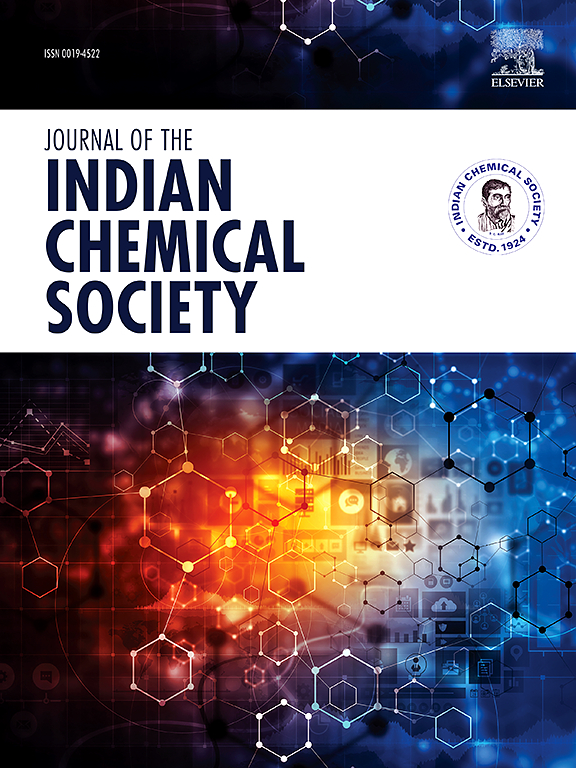SCN和二硫醇配体配合物在溶剂热绿色合成高指数二元PbS和SnS半导体纳米颗粒中的应用
IF 3.2
4区 化学
Q2 CHEMISTRY, MULTIDISCIPLINARY
引用次数: 0
摘要
二元PbS和SnS纳米粒子由于其光学和光催化特性,在材料化学研究中占据主导地位。因此,在本研究中,乙酰乙酸乙酯和水杨醛经环加成和环缩合形成的中间体(3-乙酰香豆素)与硫代氨基脲在乙醇中反应,制备了(E)-2-(1-(2-氧-2-铬-3-基)乙基肼碳硫酰胺[H3L3]。用相应的Pb(II)和Sn(II)盐在N, N ' -双环己基二硫代乙酰胺和[H2L2]的乙醇溶液中成功地合成了金属配合物。所得产物通过红外光谱和微量元素分析进行了表征。相应配合物的红外光谱频率与配体在1721.31 cm−1 (CO)、1671.72 cm−1 (CN)、1282.00 cm−1 (CS)和1721.31 (CO)、1673.30 (CN)和1281.30 (CS)的吸收频率相比,由于与Pb2+或Sn2+配位,分别发生了显著的变化。热重分析表明,失重率约为60%,可分为两个失重阶段:第一阶段发生在150-300℃范围内,与肼碳硫酰胺衍生物配体去除相关的失重率为42%;第二阶段发生在300 - 400℃之间,二环己基衍生物的失重率为18%。以前体金属配合物为原料,分别在200、240和250℃的油胺和十二烷基硫醇溶剂热分解法制备了PbS和SnS纳米颗粒。采用P-XRD、SEM-EDX、TEM和HRTEM对制备的纳米颗粒进行了表征。得到了空间群为F m−3 m的PbS方铅矿和空间群为Pb n m的正方晶矿的纯立方晶相。晶粒尺寸随温度的变化而变化,PbS纳米颗粒的平均直径在16.34 ~ 19.34 nm之间,粒径在21.30 ~ 38.00 nm之间。同样地,获得的正交SnS纳米粒子的晶粒尺寸在13.15 ~ 22.91 nm之间,而在200℃时,团聚纳米粒子的平均尺寸为52.14 nm,在240℃时形成498.88 nm的三角形。PbS和SnS纳米晶体的能带隙和光发射强度分别为2.18 eV (570.98 nm)和2.32 eV (544.63 nm)。这些值在光伏应用的最佳范围内。本文章由计算机程序翻译,如有差异,请以英文原文为准。

Complexes of SCN and dithiol ligands for solvothermal green synthesis of high indexed binary PbS and SnS semiconductor nanoparticles
Binary PbS and SnS nanoparticles have dominated materials chemistry research due to their optical and photocatalytic potentials. Hence, in this work, (E)-2-(1-(2-oxo-2h-chromen-3-yl) ethylidene) hydrazinecarbothioamide [H3L3] was prepared by the reaction of an intermediate (3-acetylcoumarin) formed by cycloaddition and cyclocondensation of ethyl acetoacetate and salicyaldehyde with thiosemicarbazide in ethanol. The metal complexes were then successfully synthesised in ethanolic solution of N, N′-dicyclohexyldithiooxamide and [H2L2] with the corresponding Pb(II) and Sn(II) salts. The products obtained were characterized by FT-IR spectroscopy and micro elemental analysis. IR frequencies of the corresponding complexes show significant shifts from the absorption frequencies of the ligand at 1721.31 cm−1 (C![]() O), 1671.72 cm−1 (C
O), 1671.72 cm−1 (C![]() N), 1282.00 cm−1 (C
N), 1282.00 cm−1 (C![]() S) and 1721.31 (C
S) and 1721.31 (C![]() O), 1673.30 (C
O), 1673.30 (C![]() N), and 1281.30 (C
N), and 1281.30 (C![]() S) due to coordination to Pb2+ or Sn2+, respectively. Thermogravimetric analysis indicated weight loss of about 60 %, subdivided into two weight loss stages: the first stage occurred in the temperature range 150–300 °C, accounting for 42 % loss related to the removal of hydrazinecarbothioamide derivative ligand, while the second occurred between 300 and 400 °C, 18 % weight loss accounting for the dicyclohexyl derivative. PbS and SnS nanoparticles were equally synthesised from their precursors metal complexes through solvothermal decomposition at 200, 240 and 250 °C in oleylamine and dodecanethiol. P-XRD, SEM-EDX, TEM and HRTEM were used to characterise the resulting stable nanoparticles. Pure cubic crystal phase of PbS NPs (galena) with a space group of F m −3 m and orthorhombic SnS NPs (Herzenbergite) with P b n m space group were obtained. The crystallite sizes varied with temperature, as the average diameter for PbS nanoparticles ranged from 16.34 nm to 19.34 nm, while the particle size varied from 21.30 to 38.00 nm. Similarly, the orthorhombic SnS NPs obtained have crystallite size ranging from 13.15 to 22.91 nm, while the agglomerated nanoparticles measured an average of 52.14 nm at 200 °C, and a triangular shape of 498.88 nm was formed at 240 °C. The energy bandgaps and optical emission of the PbS and SnS nanocrystals were found to be 2.18 eV (570.98 nm) and 2.32 eV (544.63 nm), respectively. These values are within the optimum range for photovoltaic applications.
S) due to coordination to Pb2+ or Sn2+, respectively. Thermogravimetric analysis indicated weight loss of about 60 %, subdivided into two weight loss stages: the first stage occurred in the temperature range 150–300 °C, accounting for 42 % loss related to the removal of hydrazinecarbothioamide derivative ligand, while the second occurred between 300 and 400 °C, 18 % weight loss accounting for the dicyclohexyl derivative. PbS and SnS nanoparticles were equally synthesised from their precursors metal complexes through solvothermal decomposition at 200, 240 and 250 °C in oleylamine and dodecanethiol. P-XRD, SEM-EDX, TEM and HRTEM were used to characterise the resulting stable nanoparticles. Pure cubic crystal phase of PbS NPs (galena) with a space group of F m −3 m and orthorhombic SnS NPs (Herzenbergite) with P b n m space group were obtained. The crystallite sizes varied with temperature, as the average diameter for PbS nanoparticles ranged from 16.34 nm to 19.34 nm, while the particle size varied from 21.30 to 38.00 nm. Similarly, the orthorhombic SnS NPs obtained have crystallite size ranging from 13.15 to 22.91 nm, while the agglomerated nanoparticles measured an average of 52.14 nm at 200 °C, and a triangular shape of 498.88 nm was formed at 240 °C. The energy bandgaps and optical emission of the PbS and SnS nanocrystals were found to be 2.18 eV (570.98 nm) and 2.32 eV (544.63 nm), respectively. These values are within the optimum range for photovoltaic applications.
求助全文
通过发布文献求助,成功后即可免费获取论文全文。
去求助
来源期刊
CiteScore
3.50
自引率
7.70%
发文量
492
审稿时长
3-8 weeks
期刊介绍:
The Journal of the Indian Chemical Society publishes original, fundamental, theorical, experimental research work of highest quality in all areas of chemistry, biochemistry, medicinal chemistry, electrochemistry, agrochemistry, chemical engineering and technology, food chemistry, environmental chemistry, etc.

 求助内容:
求助内容: 应助结果提醒方式:
应助结果提醒方式:


